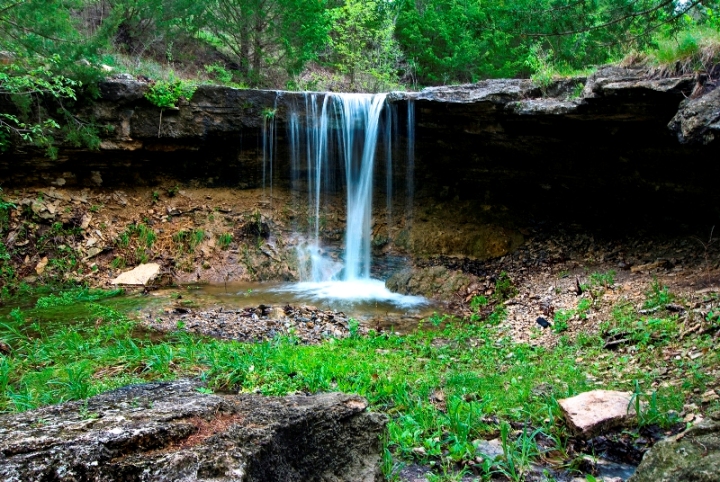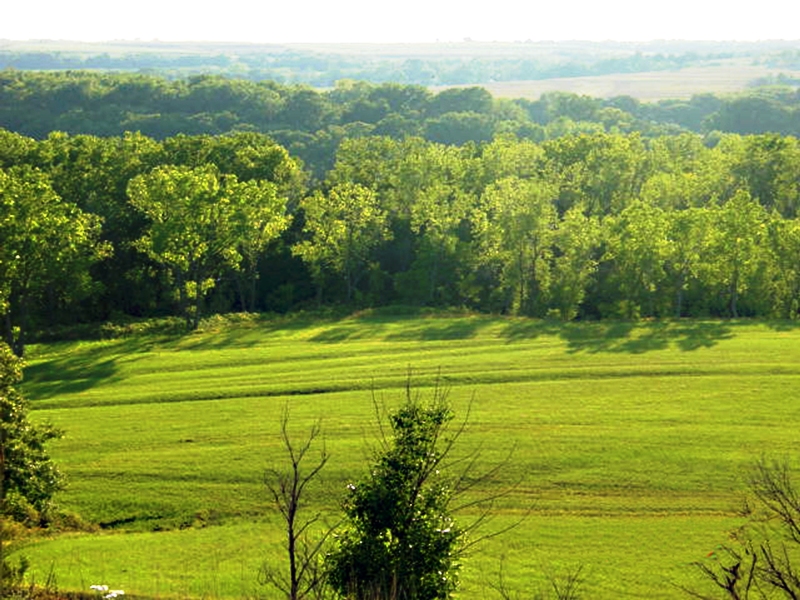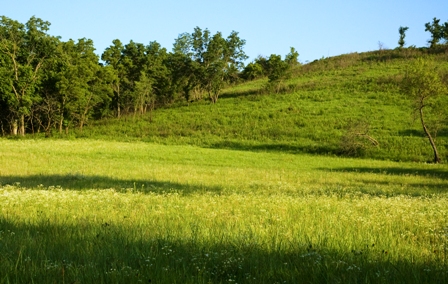Alcove Spring is one of the 8 Wonders of Kansas Geography because...of its historical significance as a stop for Indians, fur traders, and emigrants on the Oregon Trail, with wagon ruts, an intermittent waterfall, and a long-flowing spring as the main features.
 |
Alcove Spring, credit Tom Parker
|
THE STORY OF ALCOVE SPRINGSource: www.octa-trails.org
INDIAN CAMPSITE
Alcove Spring was a familiar campsite near the Independence Crossing of the Big Blue River. Before the great migration began it had been used by Indians as a campsite on hunting trips. John C. Fremont camped near there on one occasion.
FAMOUS EMIGRANT STOP
Thousands of emigrants camped near the site while waiting to cross the river, which as often as not was in flood stage, when they reached this part of their trip. The spring area was used as a campground by fur traders at least as early as 1827. James Clyman camped there while headed for St. Louis with a mule train of furs. One of the earliest references to the spring by emigrants came in 1843, the year of the "Great Migration," when more than 900 people started across the trail to Oregon. It was named by members of the Donner-Reed party in 1846. It is the final resting place for many emigrants, most notably Sarah H. Keyes, the mother-in-law of James F. Reed of that famous group of people. Sarah Keyes died, at the age of 70, on May 29, 1846.

|
Oregon Trail wagon swales are visible in this photo.
Photo credit Duane Iles
|
When the Donner-Reed party headed west, Mrs. Keyes refused to remain behind, despite her advanced age. Eliza P. Donner Houghton later remembered that, as the men built a raft to ford the swollen Blue River, "there was ... sorrow instead of rejoicing in Camp, for Mrs. Reed's aged mother, who had been failing for some days, died that night. At two o'clock the next afternoon she was buried at the foot of a monarch oak in a neat cottonwood coffin made by men of the party, and her grave was marked by a headstone." The exact location of her grave is unknown today; the marker at the site, erected by the Daughters of the American Revolution, commemorates her death. The inscription reads "God in His love and charity has called in this beautiful valley a pioneer mother."
THE WATERFALL
The site is well known for the waterfall near the spring. It is called Naomi Pike falls after the young member of the Donner-Reed party. Its water is supplied by a wet weather spring, therefore, there is only a waterfall in the spring of the year. By early summer it has stopped. There are many carvings on the ledge of the waterfall and rocks in the surrounding area. Some of the carvings are thought to date from the emigrant era. One of these carvings is by J. F. Reed. There is a carving of the words Alcove Spring, thought to have been made by the Donner-Reed party.
FIRST PERSON DESCRIPTIONS OF THE SPRING

|
This meadow is adjacent to the spring where the oxen and horses could be well fed. Photo courtesy Frank Thompson
|
Edwin Bryant, 1846:
"This afternoon, accompanied by several of the party, I strolled up the small branch, which I have previously mentioned as emptying into the river just above the ford. About three-fourths of a mile from our camp we found a large spring of water, as cold and pure as if it had just been melted from ice. It gushed from a ledge of rocks, which composes the bank of the stream, and falling some ten feet, its waters are received into a basin fifteen feet in length, ten in breadth, and three or four in depth.
"A shelving rock projects over this basin, from which falls a beautiful cascade of water, some ten or twelve feet. The whole is buried in a variety of shrubbery of the richest verdure, and surrounded by small mound-shaped inequalities of the prairie. Altogether it is one of the most romantic spots I ever saw. So charmed were we with its beauties, that several hours unconsciously glided away in the enjoyment of its refreshing waters and seductive attractions. We named this Alcove Spring; and future travellers will find the name graven on the rocks, and on the trunks of the trees surrounding it."
George McKinstry, May 30, 1846:
"About a half mile from Camp up the spring branch on the right hand fork is a most beautiful spring and a fall of water 12 feet. Mr. Bryant of our party has named it the 'Alcove Spring' ...I this day cut the name of the spring in the rock on Table at the top of the falls."
MESSAGE CENTER
Alcove Spring was also host to one of the message centers found on the overland trails. In 1849, William Johnson noted: "We found here also one of the kind of post offices peculiar to the plains -- a stick driven into the ground, in the upper end of which, in a notch, communications are placed, intended for parties following. A letter in this post office was found addressed to Captain Pyle. It was from Captain Paul, giving information that at this place his driver, John Fuller, had accidentally shot and killed himself whilst removing a gun from the wagon."
WHAT YOU'LL SEE WHEN YOU VISIT IN 2010
Brochures and maps of the site can be found in a kiosk in the parking lot. Also in the parking area is a marker designating the Oregon Trail Memorial Garden. This is the site of future specimen plantings of indigenous flora and will be dedicated to the memory of trail historian, Gregory M. Franzwa.
Walking down the trail, the visitor crosses a stone ledge that in the spring forms a beautiful waterfall. Across the foot bridge is a National Park Service wayside exhibit describing the site and indicating historic carvings in the stone ledge and below the waterfall. Emerging from the stone ledge below the foot bridge is the spring from which its name is derived.
Across the road from the parking area is a marker placed by the DAR in 1950 commemorating Sarah H. Keyes, of the Donner-Reed party, who is buried in the park. Behind the marker, the trail leads across a set of wagon swales (remnants of the wagon trails) to more descriptive signs. The meadow was a campground for the emigrants and has many wagon swales traveling from north to south that led to Independence Crossing, where the wagons crossed the Big Blue River.
Self-guided tour maps and new signs will be available later in 2010, mapping the nearly five miles of trail that connect the historic aspects of this 223-acre park. Many types of terrain are visible, since Alcove Spring is at the uppermost edge of the flint hills, near the southern reaches of the glaciers and was along the great inland ocean.
OWNERSHIP
A National Register of Historic Places property, it is owned by the Alcove Spring Historical Trust of Blue Rapids and operated by the Alcove Spring Preservation Association. In 2006, Alcove Spring was named a "Certified Historic Site" by the National Park Service.
Directions: From Blue Rapids, two miles north on U.S. 77, then at the sign go 6 miles west on a gravel road.
Contact: Duane Iles, 96cruisin@embarqmail.com.


